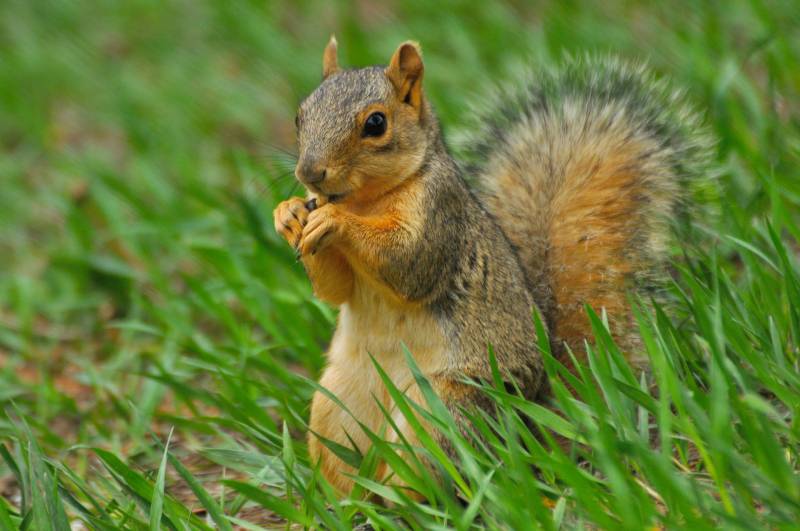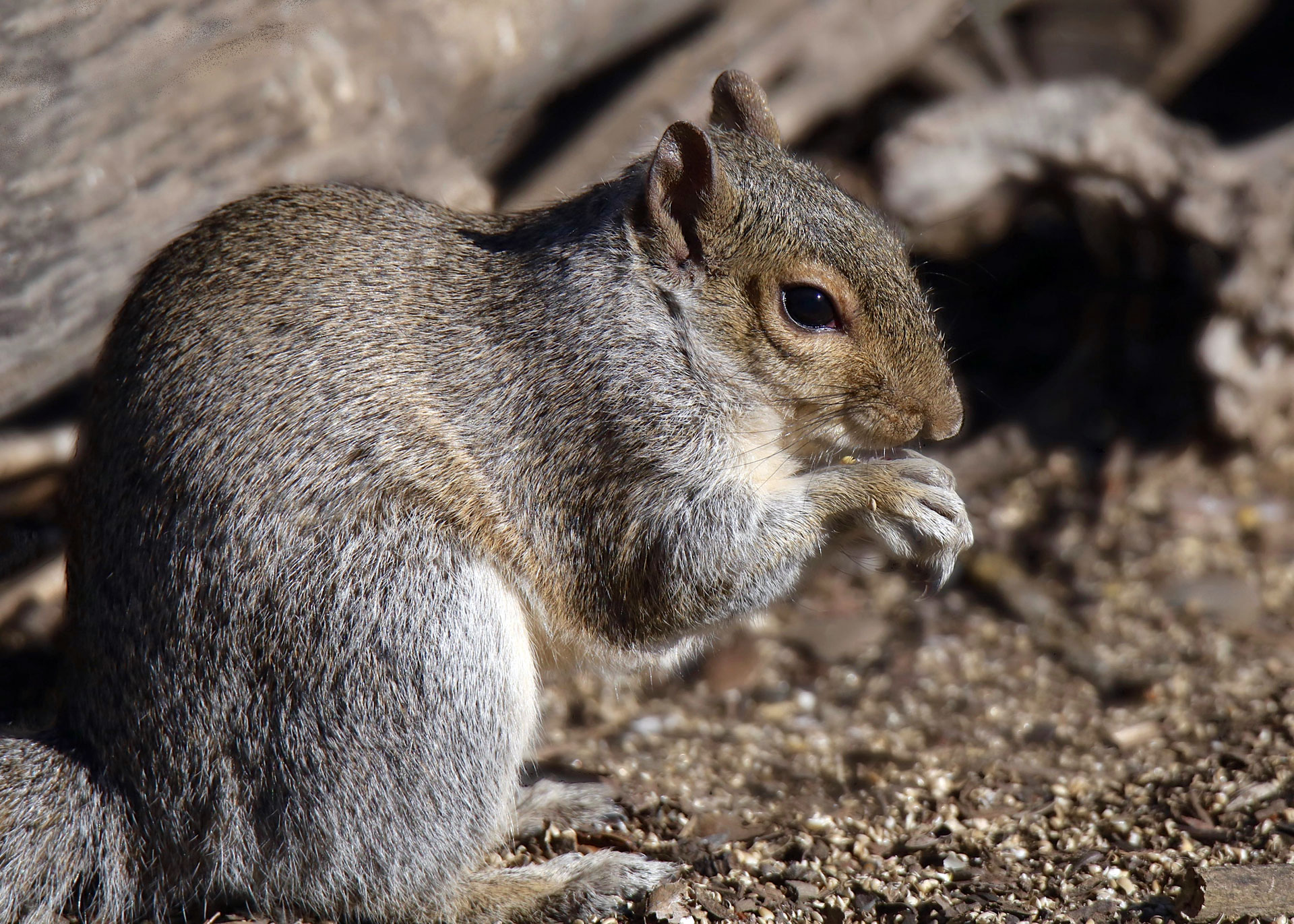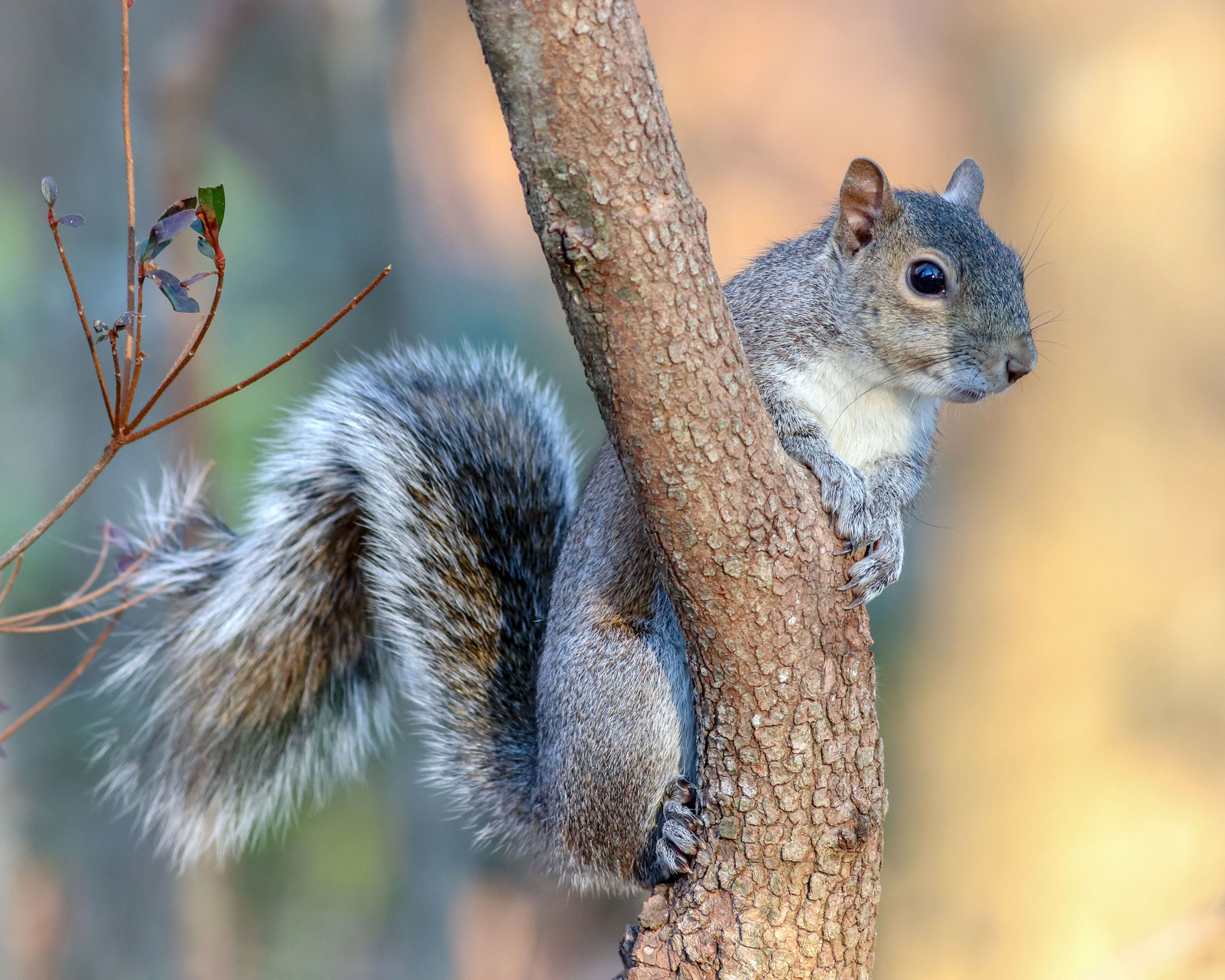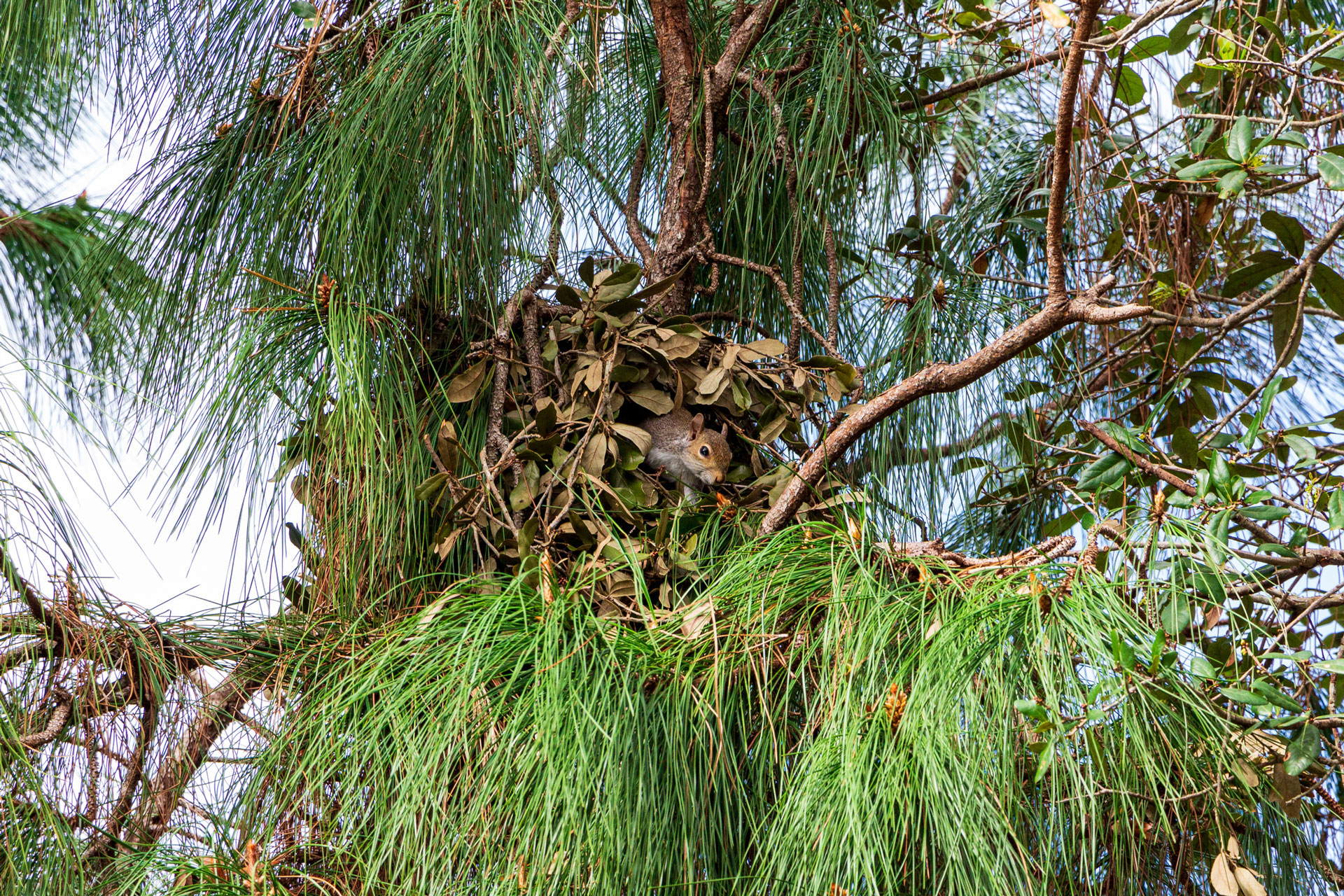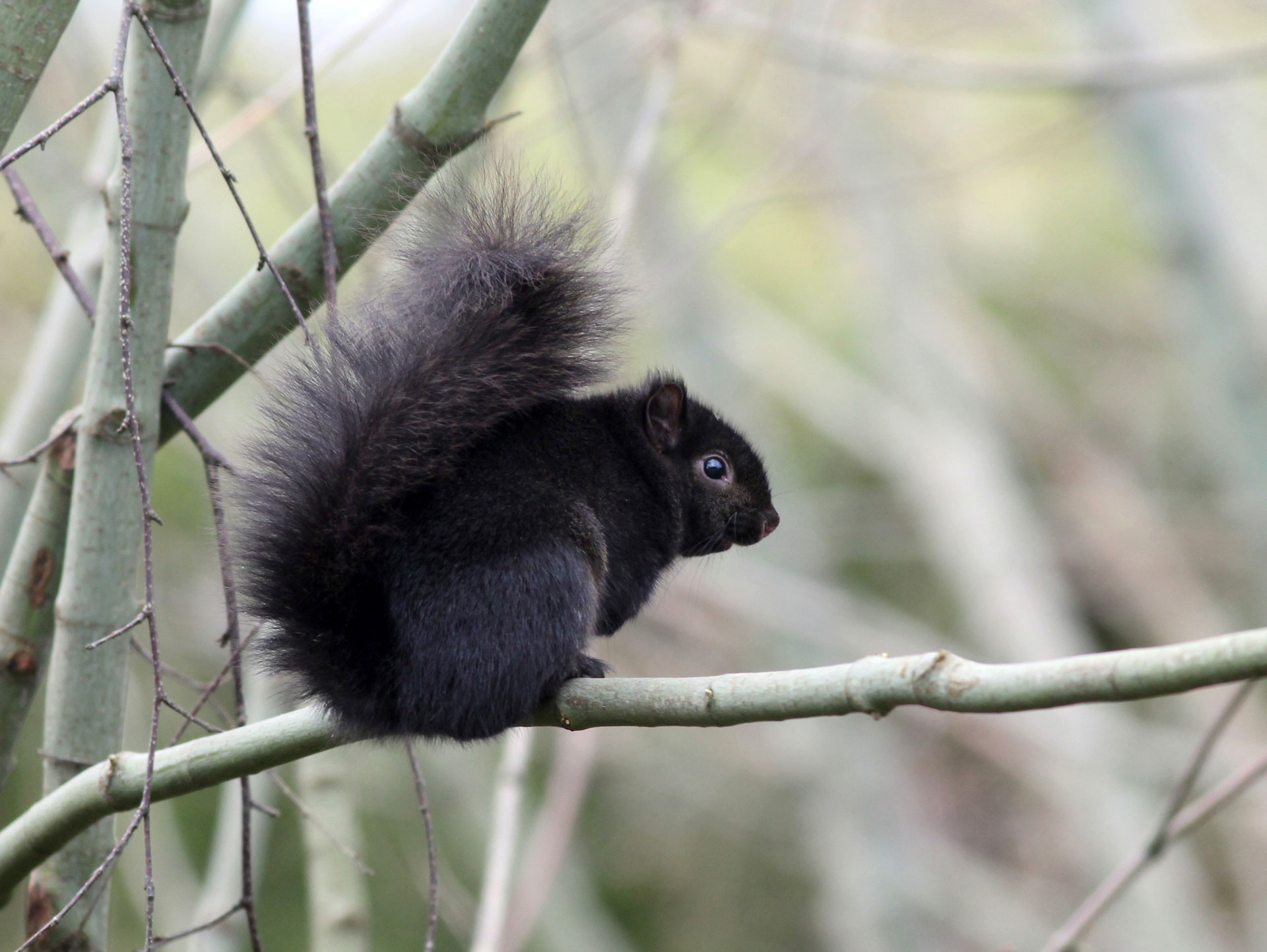Episode Transcript
Olivia Allen-Price: When it comes to squirrels, I think there are two kinds of people in this world. There are people like my husband Sam, who call them …
Sam Price: Tree rats.
Olivia Allen-Price: They see squirrels as a nuisance, just another pest that ruins the garden. And then there are people like me who, if given the chance, would happily post up under a tree and watch the squirrels do their thing all day. Their cute little cheeks as they work over a nut. Their busy tails that flick this way and that. I am quite fond of squirrels, but my affection for them is nothing compared to that of my KQED colleague Angela Corral. Angela is the senior editor of the California Report, and she seemed like the perfect reporter to tap.
Angela Corral: So it might have been the summer of 2020, now that I think about it. And that, of course, was Covid. So we were all home. My kids, my husband, me, my two kittens, my 90-pound dog. We’re all home all the time.
Olivia Allen-Price: Angela was putting peanuts out to feed the crows in her neighborhood. Which, by the way, we are not recommending. One day, she noticed someone else was interested in her offering.
Angela Corral: Suddenly, this little squirrel started coming around.
Scene sound of Angela going opening her door, saying, “Oh! Hi! Hold on.” as she sees the squirrel.
Angela Corral: I went and sat on the porch with my peanuts, and she would just come right up to me and I would toss them sort of in front of me, you know, and she would come get them without a problem.
Olivia Allen-Price: Her relationship with a little squirrel grew.
Angela Corral: And then eventually, she would take it out of my hand, and I was just tickled.
Scene sound of Angela talking to the squirrel while we hear it eating a peanut – “Hi! You’re so polite.”
Olivia Allen-Price: Angela even gave the squirrel a name. Karla.
Whimsical piano music starts
Angela Corral: And in case you’re wondering, it’s Karla with a K.
Olivia Allen-Price: Years went by and Karla became part of the family.
Angela Corral: My giant dog started treating Karla as if she was like one of our pets. She didn’t get worked up or excited when Karla would come to the door. They would nearly sniff noses on the porch.
Olivia Allen-Price: Angela was even gifted a few squirrel-sized picnic tables that Karla would post up at.
Angela Corral: So I could sit there working. (laughing) And Karla could sit at her table eating peanuts. (laughing) And we could enjoy each other’s company.
Whimsical piano music ends. Laid-back, staccato guitar begins.
Olivia Allen-Price: Now, I know you all have stories like Angela’s, because last year we asked what you wanted to know about squirrels. I thought we would hear from a few folks, but we got more than 50 squirrel questions about everything from how they find their nuts after they’ve buried them, to whether one pesky squirrel in your yard is actually taunting your dog. So today on Big Curious, it is squirrel mania. We have lots of answers to your questions. Just ahead. I’m Olivia Allen-Price.
Music fades
Olivia Allen-Price: Many of us have noticed the playful squirrels in our yards or neighborhoods, and we have questions about these critters. KQED’s Angela Corral and I went and did some digging, har har, to find out the answers. Welcome, Angela.
Angela Corral: Hi, Olivia.
Olivia Allen-Price: OK, let’s start with some squirrel basics. One listener named Rita Rodriguez wants to know how many different species of squirrels are in the Bay Area. And another listener, William, wants to know if any of them are native to our region.
Angela Corral: OK, I’m going to start sort of broadly and then narrow it down because I think that will help. Worldwide, there are only three broad types of squirrels: tree squirrels, ground squirrels and flying squirrels. They are in the same family and are distant cousins of each other. I spoke to Lucia Jacobs about all this. She’s been studying squirrels for over 40 years and is a professor emerita at UC Berkeley.
Lucia Jacobs: In the Bay Area, we’ve got three species of tree squirrels. (sound of fox squirrel) The East Bay generally has the fox squirrel, which is a has kind of a orangish, you know, tawny fur. (sound of eastern gray squirrel) And then the peninsula and Marin have the eastern gray squirrel. (sound of western gray squirrel) But then they also have the native western gray squirrel.
Angela Corral: So the western gray squirrel is native to this area, but the other two, the fox squirrel and the eastern gray, are non-native.
Olivia Allen-Price: Then we get to our ground squirrels. There are a lot of types of them but we may not think of them as squirrels, per se.
Angela Corral: So, chipmunks, prairie dogs, marmots … those are all ground squirrels. Around here you’ll likely see the California ground squirrel … they live in colonies and build networks of burrows underground.
(Sound of California ground squirrel)
Olivia Allen-Price: OK, A listener named Heather Young says she’s heard squirrels often called “rodents with tails.” I mentioned earlier, my husband calls them “rats with tails.” Is that characterization fair? And how closely related to rats are squirrels?
Angela Corral: Well, squirrels are in the rodentia order. So, in a way, they are cousins to rats and are often considered pests that can carry disease.
Olivia Allen-Price: Oh… It’s amazing how far some fur and some cute eyes really goes a long way.
Angela Corra: Really it does.
Olivia Allen-Price: (laughing) Uh, OK, Moving on … We got a whole bunch of questions about the daily life of squirrels. You know, we often see them out there, doing their squirrel thing all alone. But sometimes you’ll see some of them hanging together. What is the social life of a squirrel like?
Angela Corral: Well, a pretty adorable fact is that squirrels do seem to be somewhat social. The eastern gray squirrel in particular. They share nests sometimes to stay warm and seem to sort of at least “know” one another, although Lucia says we’re not sure how they choose their nest mates… and they need to do more research on the topic.
Olivia Allen-Price: What about when you see three or four squirrels chasing each other all over the place, what are they doing?
Angela Corral: If they’re babies, they might actually be playing. But if they look mature, it’s probably a mating chase.
Olivia Allen-Price: Oooo!
Lucia Jacobs: Females come into heat just twice a year. And the males come in from all over, and then the female leads them on this big chase, and that’s her way of deciding who she’s going to you know, grace with her genetic material.
Olivia Allen-Price: I’ve always wondered where squirrels sleep because I’ve never caught one snoozing. And it turns out they collect green leaves and make these huge nests high up in the branches of trees…away from predators. They line them with chewed-up bark to make them cozy…and they can live in them even when it’s really cold. These leaf nests are also where their babies are born and raised.
Lucia Jacobs: They’re not independent, really, till they’re like 13, 14 weeks old, so they’re sticking around the nest. And they have so much to learn. They have to learn how to open nuts. They have to learn how to cache; how to move in the trees.
Olivia Allen-Price: Watching squirrels move through trees is probably what I find most compelling about them. It is some serious parkour!
Angela Corral: It’s amazing.
Olivia Allen-Price: When we see a squirrel in a yard or park, a lot of what they’re doing is finding and burying nuts for the winter. Many of the questions listeners sent us were about the nuts and bolts of squirrels’ nut hoarding if you will… Sean Malley wants to know if squirrels remember all the places they’ve buried something?
Angela Corral: That’s exactly the type of question Lucia gets fired up about because she’s been studying this squirrel behavior for years. She cautioned that it’s really hard to control for all the variables that exist in the wild, but says studies of squirrels in captivity showed that they found twice as many nuts that they had buried as compared to nuts another squirrel had buried. So, that indicates that yes, they do remember where they buried nuts. They treat different types of nuts differently depending on how much they value them.
Lucia Jacobs: My graduate student at the time, Stephanie Preston, showed that they actually shake the nut in their mouth to estimate the mass of the nut. And depending on how heavy it is, they will carry it farther away from the competition.
Olivia Allen-Price: Wow, so they’re making an economic decision about the value of a nut-based on its mass … how fascinating. And I take it they like big nuts?
Angela Corral: They like big nuts.
Olivia Allen-Price: But squirrels aren’t just paying attention to a nut’s mass. They also care about the type of nut.
Lucia Jacobs: My other graduate student, Michael Delgado, showed the better the nut, the more time they spend. Even if you give them a random series of nuts, they will organize them as they’re caching them. And so at the end of the day, they’ve got the almonds over here, and the walnuts over there, and the peanuts over there.
Angela Corral: And in addition to this orderly system, they actually use some stealth tactics to protect their “best nuts.”
Lucia Jacobs: They bury them at a specific density. So the distance from one almond to the next is different than the distance from one walnut to the next because a walnut is a much bigger, more valuable nut. And so you don’t want to lose that. So what they do is they bury the walnuts more spread out so that if one squirrel finds one of their walnuts, they’re not going to immediately find their other walnuts.
Olivia Allen-Price: Smart! We heard from a lot of dog owners when we asked for listener squirrel questions… like this one…
April Whitney: This is April Whitney from Vallejo. My dog goes ballistic every time he sees a squirrel on my fence. Why do they return every day instead of just avoiding my yard? Are they gluttons for punishment or do they just love to create chaos?
Angela Corral: A question I, too, have had. The expert, Lucia, says studies of other animals have shown that they will approach a predator when they know they aren’t hungry, just to sort of study the predator. And it’s possible squirrels are doing that with dogs. But also.
Lucia Jacobs: Animals have a great sense of humor. I wouldn’t put it past a squirrel to be teasing it, too.
Olivia Allen-Price: So sounds like a yes, that squirrel may in fact be messing with your dog. For the fun of it…
Angela Corral: Yeah, absolutely.
Olivia Allen-Price: For the squirrel detractors out there, one key complaint is that they eat the birdseed you’re leaving out… If this is a problem for you, they actually make birdseed covered in red chili pepper that could do the trick!
Lucia Jacobs: Birds don’t have the taste receptors, so that the birds don’t care, and the squirrels definitely do.
Angela Corral: And if squirrels are planting nuts in your flowerpots and then digging up your flowers when they come back…Lucia recommends sprinkling some cayenne pepper on the soil.
Olivia Allen-Price: Ooo spicy!
Any other little factoids Lucia shared that grabbed you?
Angela Corral: We haven’t talked about squirrel tails yet and why they’re so fluffy. I know listener Alice Hong wanted to know more about this. Lucia says squirrels use their tails for all kinds of things – insulation to keep them warm in the nest, you know they curl up in them, balance as they’re jumping all over the powerlines, but also they show emotion with their tails, kind of like cats.
Lucia Jacobs: When you gave them a problem to solve that was very easy to solve, and then you suddenly made it impossible, they would get very frustrated. And you would see them changing their tail movements. But they also use it as a social signal.
Olivia Allen-Price: Alright, well I now know more about squirrels than I thought I’d ever know, maybe ever want to know. Thank you for bringing us all this great information, Angela.
Angela Corral: It was my pleasure. I feel like I understand Karla a little better now.
Olivia Allen-Price: Angela Corral is the Senior Editor of the California Report.
That’s it for our squirrelmania episode – almost anyway. A few years ago we had a short piece about the black squirrels you might see roaming around, especially on the Stanford campus. Stick around after the credits to learn about them and you can keep listening for our monthly podcast trivia game, too!
Bay Curious is made in San Francisco by member-supported KQED. Our show is produced by Katrina Schwartz, Christopher Beale, and me, Olivia-Allen Price. Additional support from Jen Chien, Katie Sprenger, Cesar Saldana, Maha Sanad, Holly Kernan and the whole KQED family.
Now we bring in reporter Ryan Levi who answered this question about black squirrels for Bay Curious some years ago. The question came from listener Ayal Sadone. He was at Stanford, getting his PhD in electrical engineering.
Ayal Sadone: I was walking with my girlfriend, and she told me that apparently, the black squirrels in Stanford are actually a Stanford genetic experiment, run amok and that they don’t exist anywhere outside of Stanford.
Olivia Allen-Price: I’ve seen those black squirrels and I think I definitely did a double take the first time I saw one.
Ryan Levi: Me too. And so I called up Cheryl Green. She’s a veterinarian and a professor at Stanford School of Medicine. And she says they get calls all the time about this myth, but it’s just not true.
Cheryl Green: The truth really is that the black squirrel is a squirrel that is produced when these eastern gray squirrels who carry a normal gene mutation mate and their offspring grow a black coat.
Olivia Allen-Price: So we can think of the black squirrels kind of like the redheads of the squirrel world. If both parents have the black fur gene, they can pass it on to their little ones.
Ryan Levi: Exactly. And they’re not just in Palo Alto or even just in California, Green says. They’ve been seen on the East Coast since the 17 hundreds, and they show up out here until the turn of the 20th century.
Olivia Allen-Price: OK. But that doesn’t really explain why there are so many of them on Stanford’s campus.
Ryan Levi: Right. And so I asked Cheryl Green about this and she said there’s no hard scientific evidence or data about why there are so many out here. But anecdotally, it seems like the Black fur could be an evolutionary advantage. It helps them stay warmer. Some folks have said that the black squirrels are more aggressive and they have fewer predators than their non black brethren. And also it seems like the black fur might stand out a little better against our gray streets, meaning that the black squirrels are less likely to show up as roadkill.
Olivia Allen-Price: That’s dark.
Ryan Levi: Yeah, it is. But I took the answer back to our question, Ayal, and he said in this case, he actually kind of likes the fiction a bit more than the fact.
Ayal Sadone: I think I will stick with the urban legend one.
Ryan Levi: Even though you know the real answer, you’re going to stick with the urban legend?
